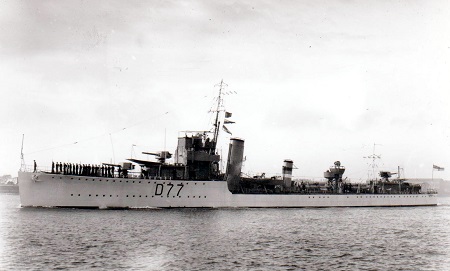
HMS Whitshed – At the outbreak of hostilities, she was reactivated and assigned to the 18th Destroyer Flotilla at Portland for convoy defence. On 30 January 1940, in conjunction with the sloop Fowey and an RAF Sunderland flying boat from No. 228 Squadron, Whitshed sank U-55 in the South-West Approaches whilst escorting convoy OA30G.
Transferred to Dover after the commencement of the German Blitzkrieg, she played a major role in the demolition of port facilities at IJmuiden and Amsterdam. On the 14th May, as part of the operation to rescue the Dutch royal family, she evacuated a contingent of Irish and Welsh guards (Harpoon Force) from the Hook of Holland
On 22 May, Whitshed was the escort leader for ships carrying troops of the 20th Guards Brigade to Boulogne. On her return journey, she carried RAF personnel, POWs and civilians back to England. With the situation in Boulogne rapidly deteriorating, Whitshed was back in Boulogne by 15.00 hours the following day, to evacuate around 250 wounded soldiers. While there, she assisted the Irish Guards in taking out enemy positions in the town with her 4.7 inch guns. Later that evening, under RAF air cover, Whitshed, along with sister ship Vimiera, re-entered Boulogne and each ship embarked around a thousand men.
HMS Whitshed participated in Operation Dynamo and managed to come through the operation unscathed. However, on the 31st July, 1940 she was seriously damaged by a mine off Harwich and was under repair for the remainder of that year.
The remaining years of the war saw her play an active role as a patrol and convoy escort in the North Sea and English Channel. This included a torpedo attack on the German battleships Scharnhorst and Gneisenau during the infamous "Channel Dash" in January 1942. She also participated in the Normandy landings in 1944 before being placed into reserve in 1945 and finally scrapped in 1948.
